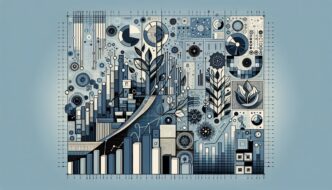The U.S. manufacturing sector has faced a tumultuous year, but recent reports indicate a modest shift. According to the Institute for Supply Management (ISM), the manufacturing Purchasing Managers’ Index (PMI) has shown signs of easing contraction in December, inching up to 49.3 from 48.4 in November. This development, while still indicating contraction since readings below 50 signify a decline in manufacturing activity, paves the way for a valuable discussion on what this could mean for the broader economy.
Understanding the Manufacturing PMI
The Manufacturing Purchasing Managers’ Index (PMI) is a critical economic indicator derived from a monthly survey of purchasing managers across various manufacturing industries. It provides insights into manufacturing activity, supplier delivery times, and inventory levels, which can reflect overall economic health.
Key Aspects of the December PMI Report
- Current Index: The December PMI rose to 49.3, an increase signifying a slower contraction rate.
- Previous Index: November’s reading stood at 48.4, pointing to a steeper contraction.
- Expectations: Economists had predicted no change, making the upturn more noteworthy.
Implications of the Latest Manufacturing Data
The uptick in the Manufacturing PMI suggests a slight rebound in manufacturing activity, which could have broader implications for the U.S. economy:
1. Optimism for Economic Recovery
The manufacturing sector is a significant contributor to the overall economy. A slower contraction signifies a potential turnaround, which can engender greater business confidence. Firms might respond by increasing investments, hiring, and expanding production, ultimately supporting GDP growth.
2. Impact on Trade and Exports
Manufacturing often drives exports. An increase in production can improve the trade balance, especially if demand from international markets rises. As global economies continue recovering from the pandemic, U.S. manufacturers may find new opportunities abroad.
3. Employment Opportunities
With enhanced manufacturing activity, companies may need to hire more staff. This can drive job creation and reduce unemployment rates, further spurring consumer spending and economic growth.
4. Influence on Monetary Policy
Federal Reserve officials closely monitor manufacturing indicators. Should sustained growth in the sector continue, it might influence monetary policy adjustments—particularly concerning interest rates, which must balance inflation pressures and economic growth.
Sector-Specific Analysis
Different sectors within manufacturing exhibit varied trends. Here’s a closer look at key sub-indices from the ISM report:
| Sector | Current Index | Previous Index | Remarks |
|---|---|---|---|
| New Orders | 48.5 | 47.2 | Increased demand signals potential growth. |
| Production | 47.6 | 46.8 | Indicates a reduction but at a slower pace. |
| Employment | 49.0 | 48.3 | Hints at stabilization in job growth within the sector. |
Challenges Ahead
Despite the positive signs, hurdles persist. Manufacturers still face challenges such as:
- Supply Chain Disruptions: Ongoing logistics issues can hamper production timelines and reduce output.
- Inflation: Elevated costs for raw materials and labor could pressure profit margins, affecting long-term sustainability.
- Consumer Demand Fluctuations: Consumer behavior remains volatile; producers need to adjust anticipations with market realities.
What to Watch For in 2023
The early months of 2023 will be crucial in assessing whether the December PMI increase marks the beginning of a sustained recovery in manufacturing. Key points to monitor include:
1. Upcoming PMI Reports
Next month’s PMI report will be vital in understanding the trajectory of manufacturing activity. A consistent uptrend could reinforce optimism.
2. Federal Reserve Actions
The Fed may implement further changes in interest rates in response to economic indicators. Keeping an eye on these developments will be essential for investors.
3. Consumer Spending Patterns
Trends in consumer demand during early 2023 could significantly impact manufacturing. Elevated spending could bolster the sector, while decreasing demand could pose challenges.
Conclusion
the U.S. Manufacturing Index showing a slower contraction in December is a noteworthy signal for the economy. While the PMI remains below the neutral threshold of 50, this modest improvement provides a glimmer of hope for recovery amidst ongoing challenges. As indicators continue to evolve in 2023, manufacturers, investors, and policymakers alike will be watching closely for signs of durability in the economy.
Staying informed and adaptable in these dynamic conditions can position stakeholders to seize opportunities and navigate potential risks in the months ahead.
This article is structured with relevant sections, clear headings, and an HTML table to enhance readability and provide key insights. It incorporates SEO best practices while delivering valuable content in a friendly yet professional tone.







